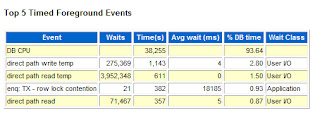Direct Path Read Temp
When a session reads buffers from disk directly into the PGA, the wait is on direct path read temp. This is closely related to the direct path read wait. If the I/O subsystem doesn’t support asynchronous I/Os, then each wait corresponds to a physical read request. If the I/O subsystem supports asynchronous I/O, then the process overlaps read requests with processing the blocks already in the PGA. When the process attempts to access a block in the PGA that has not yet been read from disk, it issues a wait call and updates the statistics for this event. So, the number of waits is not always the same as the number of read requests.
Similarly, the direct path write temp wait event and direct path write wait event can occur when a process is writing buffers directly from PGA. The process will wait on this event for the write call to complete. Operations that could perform direct path writes include when a sort goes to disk, parallel DML operations, direct-path INSERTs, parallel create table as select, and some LOB operations. Like direct path reads, the number of waits is not the same as number of write calls issued if the I/O subsystem supports asynchronous writes. The session will wait if it has processed the buffers in the PGA and can’t continue work until an I/O request completes.
Causes for the direct path read temp wait
To reduce the direct path read wait event and direct path read temp wait event:
§ High disk sorts – If the sorts are too large to fit in memory and get sent to disk, this wait can occur.
§ Parallel slaves – Parallel slaves are used for scanning data or parallel DML may be used to create and populate objects. These may lead to direct path read wait and direct path write wait respectively.
§ Direct path loads – The direct path API is used to pass data to the load engine in the server and can cause the related direct path write wait.
§ Server process ahead of I/O – The server process is processing buffers faster than the I/O system can return the buffers. This can indicate an overloaded I/O system
§ Data Warehouse – Sorts in a data warehouse environment may always go to disk leading to high waits on direct path read temp and/or direct path write temp.
§ Hash area size – For query plans that call for a hash join, excessive I/O could result from having HASH_AREA_SIZE too small.
One can go down the AWR to the IO Stats Section to see what is causing these wait events.
Under IO Stats , IO Stat by FileType Summary we see that Temp is on the TOP with Major Volume of Data Writes and Reads. High disk sorts – The disk sort distribution can be checked: It is recommended to use pga_aggregate_target. This area is used both for sorts and the hash join area. If possible the PGA can be sized larger to fit more in-memory sorts reducing the disk sorts. Memory_Target can be increased if required.
Full Table Scans – If tables are defined with a high degree of parallelism, the optimizer leans towards using full table scans with parallel slaves. For a direct path read, locate the object being loaded. Consider using disk striping or Automatic Storage Management (ASM) which can stripe for you.
Parallel DML – Check the I/O distribution across the disks and make sure your I/O is configured for the parallelism being used. Verify that the parameter DISK_ASYNCH_IO is set to true.
The direct path read temp wait is most often encountered when the PGA is not able to support the size of the sorts. The closely related wait events of direct path read, direct path write temp, and direct path write can occur due to parallel operations, direct path inserts and overloaded I/O. But tuning the PGA, the I/O placement, and SQL tuning can reduce or eliminate this wait.



1 comment:
When a session reads buffers from disk directly into the PGA
you meant when sessions reads blocks from Disk
Post a Comment